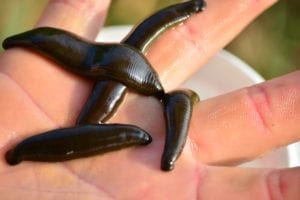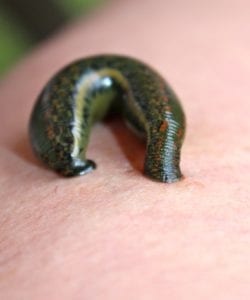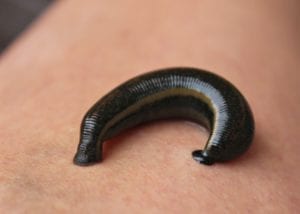Meryl Sigaton
City of Silay, Philippines

Four (4) medicinal leeches were photographed on a human hand to show comparison in size. Source
Leeches (hirudo medicinalis) are invertebrates of the phylum Annelida whose main diet is blood. They are hermaphrodites and carnivorous, having 700 species that thrive in a variety of environments. Most of them are small, weighing less than 1–1.5 g before feeding, but some may reach a length of twelve centimeters. For medical or commercial use, they are specially bred under sanitary conditions, easily conserved, and preserved at 10° to 20°C in chlorine-free salt solutions. Some hospitals keep stocks of leeches, and surgeons sometimes find them a handy option to have available.
Since ancient times patients have been bled in an effort to restore the proper balance between the four humors (blood, phlegm, black bile and yellow bile) and thus ward off diseases and restore good health. Leeches were often used for this purpose by the ancient Egyptians around 1300 BC, also in India, as described in the ancient Sanskrit text of Indian physicians Sushruta and Charaka Samhita. Using leeches was recommended by the ancient Greeks, and later by Pliny the Elder (ca. AD 23-79) for phlebitis and hemorrhoids, also by Greco-Roman physician Galen (AD 129-c. 216).

This image of the Hirudo Medicinalis (European Medicinal Leech) was photographed latching on to the human skin. Source
A demand for leeches arose in Napoleonic times after the surgeon François-Joseph-Victor Broussais published his theories and advocated their use in bloodletting procedures. It became a lucrative business as leeches were exported to the United States and throughout Europe. Enormous quantities of Hirudo medicinalis, some five to six million, were used annually and harvested to near annihilation, providing more than 300,000 liters of blood for Parisian hospitals alone. Their use declined by the end of the nineteenth century when modern ideas on microbiology and pathology were adopted and medicine began to forsake the notion that illnesses were caused by a surplus of blood.
Commercial marketing of leeches for medical purposes was approved by the U.S. Food and Drug Administration in 2004. This was after a French company, the Ricarimpex SAS, which has been breeding them for 150 years in a certified facility, requested to market them as medical devices. Thus after thousands of years of use as a substitute to blood-letting and as an adjunct to amputations, leeches became one of the first living creatures approved by the agency authenticated for clinical use.
Though tied to medical charlatanism, leeches have an authentic place in contemporary surgery to restore amputated body parts. In such cases, microsurgeons can reconnect arteries relatively easily, but veins have thin walls and are reattached with more difficulty. Here leeches enter the scene by serving as provisional substitutes for blood vessels, drawing off excess blood, and offering a less destructive approach until the venous capillaries grow back. One of the first such notable uses was in 1985 when a dog bit off the ear of a five-year-old. Attempts to reattach were not successful, a small blood clot formed, and anti-clotting agents were to no avail until Joseph Upton, a Harvard physician, attached two leeches and “the ear perked up right away.”

The anterior and posterior suckers of the European Medicinal Leech is clearly visible in this image. Source
Leeches attach to their hosts by means of two suckers, the posterior for attachment and mobility, while the anterior has three jaws consisting of about a hundred sharp teeth to cut into the skin. During this time, it can ingest within 20 to 45 minutes as much as a tablespoon of blood, and its body size may enlarge to eight to eleven times its original, possibly exceeding ten times its own weight. After dining, the leech will simply release itself and fall off, but the Y-shaped puncture they caused may continue to bleed from six to ten hours or more, sometimes causing a loss of as much as 100 mL in a single extraction. The continued bleeding is caused by the chemical hirudin, a potent anticoagulant found in leech saliva and injected through the skin during the bite. It keeps the blood flowing, preventing or breaking up clots and improving circulation, thus avoiding tissue death. If leeches need to be removed, this can be done by applying alcohol, acid such as a vinegar, or by exposing them to a flame rather than pulling in haste, which may result in leaving their jaw in the patient. At the end of a session, a desiccating fluid can then be poured on the leech to kill it off since for hygienic reasons it cannot be reused on another person.
Exemplifying the uses in reconstructive or cosmetic surgery, a woman in November 2017 developed a swelling on the tip of her nose after rhinoplasty, and leeches gained acclaim for removing the congested blood. Leech therapy itself has few side effects, but bacterial infection may occur with the predominant microbial species found in leech gut, Aeromanas hydrophilia, used to digest the ingested blood. Itching, weal formations, and blisters uncommonly occur, and antibiotics are sometimes given prophylactically before their use. In general, these small creatures remain a useful adjunct in the fields of medicine and surgery—a remarkable asset known to the field of medicine. They make you think of medieval medicine but they have “evolved to do a specific job and are good at it.”
References
- Agustyn, Adam, Patricia Bauer, Brian Duignan, Alison Eldridge, Erik Gregersen, Amy McKenna, and John Petruzzello. n.d. “Leeching.” Britannica. https://www.britannica.com/science/leeching.
- Anderson, Leigh Ann, Sanjai Sinha, Kaci Durbin, Sophia Entringer, Judith Stewart, Philip Thornton, Carmen Fookes, Melisa Puckey, and Jane Grigg. 2019. “Leeches.” Drug.com. April 24. https://www.drugs.com/npp/leeches.html.
- Baskova, I. P., I. B. Pavlova, and A. S. Parfenov. 2013. “Analysis of the Effects of Medicinal Leech on Arterial Function in Elderly Volunteers by Means of Photoplethysmography with Angioscan-01 .” Human Physiology, March 12: 214-219.
- Bauters, Tiene GM, Franky M.A. Buyle, Gerda Verschraegen, Karen Vermis, Dirk Vogelaers, Geert Claeys, and Hugo Robays. 2007. “Infection risk related to the use of medicinal leeches.” SpringerLink.
- Freiman, J. 2018. “When Leeches Are Used in Modern Medicine: Have We Turned Back Time?” Health. September 12. https://health.usnews.com/health-care/for-better/articles/2018-09-12/when-leeches-are-used-in-modern-medicine-have-we-turned-back-time.
- Gallucci, M. 2017. “Leeches suck blood from a young patient’s during a therapy session in India.” Mashable. March 4. https://mashable.com/2017/04/30/leeches-comeback-modern-medicine-russia/.
- Horowitz, K. 2016. “10 Juicy Facts About Leeches.” Mental Floss. March 10. https://www.mentalfloss.com/article/76821/10-juicy-facts-about-leeches.
- Isaac, S. 2018. “Why you should love a leech: blood letting to microsurgery.” Royal College of Surgeons.
- Krans, B., and K. Watson. 2017. “What Is Leech Theraphy.” Healthline.
- Lohr, S. 1998. “Persistent Researcher Sees Value In Leeches.” New York Times, August 16.
- Newman, Tim. 2018. “I tried leech therapy, and it was unpleasant.” MedicalNewsToday. March 29. https://www.medicalnewstoday.com/articles/321336.php#1.
- Ngan, V. 2005. “What are leeches and their use in medicine?” DermNet NZ. https://dermnetnz.org/topics/leeches/.
- Renault, M. 2019. “Modern medicine still.” Popular Science. July 8. https://www.popsci.com/medicine-leeches-blood-surgery/.
- Ridley, J. 2018. “Plastic surgery destroyed my nose — but I fixed it with leeches.” New York Post , July 24.
- Scott, K. 2002. “Is hirudin a potential therapeutic agent for arthritis?” Annals of the Rheumatic Diseases 561-562.
- Sherman, M. 2005. “Leeches Approved as Medical Devices.” Pharmacy Times, January 11.
- Zaidi, A. 2014. “Unani Treatment and Leech Theraphy Saved the Diabetic Foot of a Patient from Amputation.” International Wound Journal.
MERYL C. SIGATON is an aspiring author and senior high school student in the City of Silay, Philippines. Previous and current editor-in-chief of her school publication, she aims to pursue a psychology course in her college studies. She embraces literature and the arts through drawing, painting, and photography.
Submitted for the 2019–2020 Blood Writing Contest

Leave a Reply